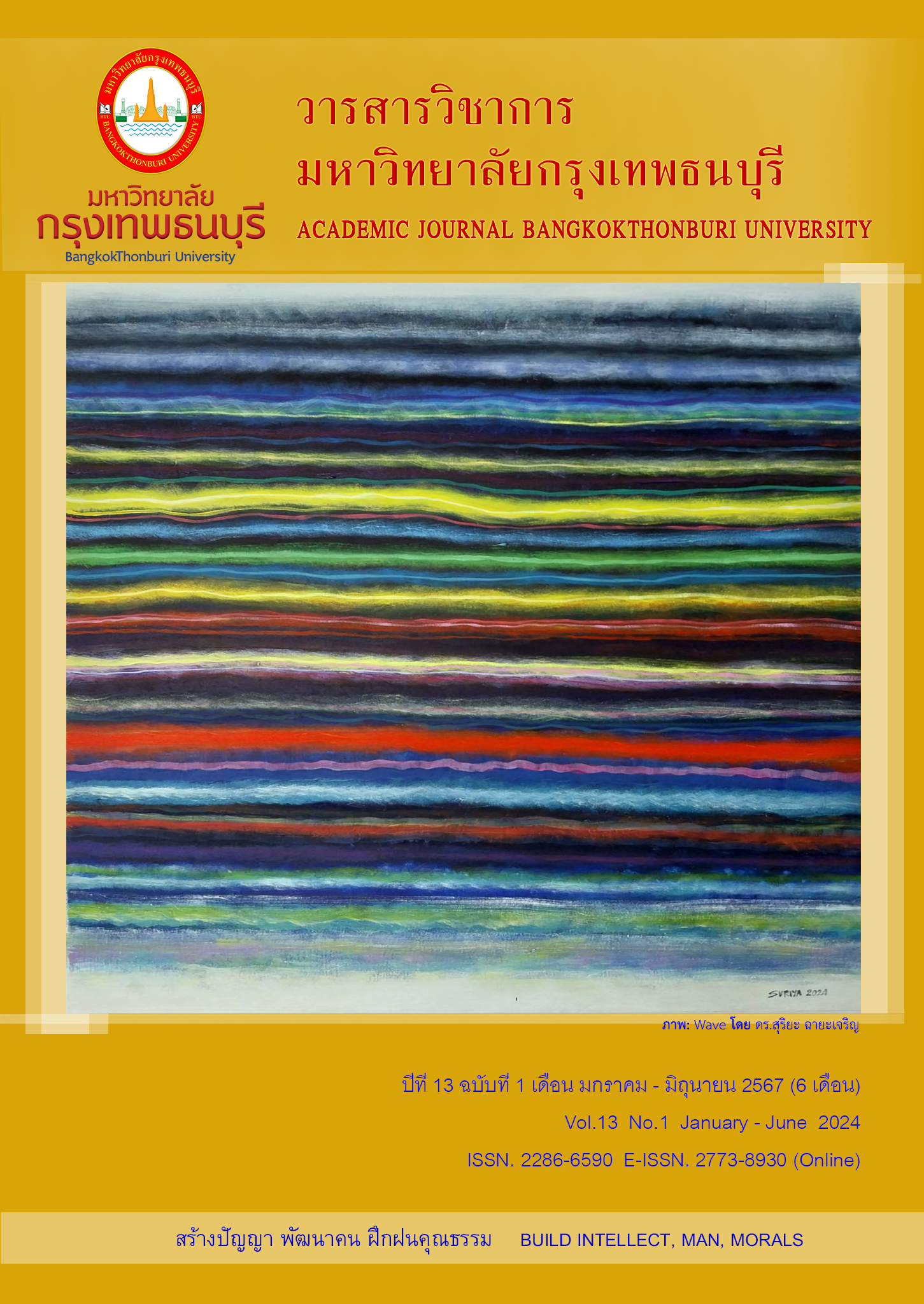Using of Generative Artificial Intelligence for teaching and learning in the higher education level
Main Article Content
Abstract
Enhancing Blended Learning with Artificial Intelligence: A Study of Multimedia and Animation Students' Perceptions and Experiences. This research explores the integration of artificial intelligence (AI) into blended learning modules for multimedia and animation students at Bangkok Thonburi University. The study aims to: Investigate the implementation of AI-assisted teaching approaches. Assess student satisfaction with AI integration in learning. And examine the advantages and limitations of AI-supported learning. The research involved 20 students from the Multimedia and Animation program. Data was analyzed using mean and standard deviation. The research instruments included: AI-integrated modules evaluated by AI experts. Student satisfaction questionnaires. And figJam web platform. The findings indicate a positive student perception of AI integration, with Microsoft Bing, Google Bard, and ChatGPT being the most preferred AI tools. Students particularly favored Microsoft Bing and were least enthusiastic about ChatGPT. The advantages of AI included the ability to search for Thai language-supported information, access reliable sources, and generate creative content. However, limitations were also identified, such as the need for precise Thai language commands, usage restrictions, and the potential for inaccurate image generation. Students demonstrated overall satisfaction with AI integration in blended learning modules. Microsoft Bing emerged as the most preferred AI tool among students. AI-supported learning was perceived as beneficial for information retrieval, resource access, and creative content generation. The need for accurate Thai language commands and potential for inaccurate image generation were identified as limitations of AI integration.
Article Details

This work is licensed under a Creative Commons Attribution-NonCommercial-NoDerivatives 4.0 International License.
References
กุลธิดา ทุ่งคาใน. (2564). การเรียนรู้แบบผสมผสาน Blended Learning ในวิถี New Normal Blended Learning in a New Normal. วารสารครุศาสตร์สาร คณะครุศาสตร์ มหาวิทยาลัยราชภัฏบ้านสมเด็จ, 15(1), 29-43.
ชูศักดิ์ เอกเพชร. (ม.ป.ป). การจัดการเรียนการสอนในศตวรรษที่ 21. เอกสารประกอบการสอน. คณะครุศาสตร์, มหาวิทยาลัยราชภัฏสุราษฎร์ธานี.
สรพงค์ สุขเกษม, ทิพรัตน์ สิทธิวงศ์, และประหยัด จิระวรพงศ์. (2562). การพัฒนารูปแบบการเรียนการสอนแบบผสมผสาน รายวิชาคอมพิวเตอร์สารสนเทศขั้นพื้นฐาน สำหรับนิสิตระดับปริญญาตรี. วารสารศึกษาศาสตร์ มหาวิทยาลัยนเรศวร, 21(4), 317-328.
สำนักวิจัยและพัฒนามหาวิทยาลัยสงขลานครินทร์. (17 ตุลาคม 2566). AI เครื่องมือช่วยทำวิจัย. https://research.psu.ac.th/AI/.
อุทิศ บำรุงชีพ. (2557). HyFlex Learning: การเรียนรู้ผสมผสานแบบยืดหยุ่นเทคโนโลยีการเรียนการสอนในศตวรรษที่ 21. วารสารศึกษาศาสตร์ มหาวิทยาลัยบูรพา, 25(1), 15-29.
แฝงกมล เพชรเกลี้ยง. (2563). การเรียนรู้แบบผสมผสาน Blended Learning. วารสารการจัดการทางการศึกษาปฐมวัย, 2(2), 67-79.
Beth Rafool, Erin Sullivan and Adel Al-Bataineh. (2012). Integrating Technology into the Classroom. The International Journal of Technology Knowledge and Society, 8(1), 57-71.
Business & Technology. (22 กุมภาพันธ์ 2566). รวม 5 บริการ AI สำหรับธุรกิจที่ใช้งานได้ทั้งแบบฟรี และมีค่าใช้จ่าย.http://aigencorp.com/5 บริการ AI/.
ETS Tech Education. (2023). ระดมสมอง ให้ได้เรื่องและได้งานด้วย FigJam. https://techintegration.ets.kmutt.ac.th/figjam.
Roger, Charley. (2018). Adaptive learning in the classroom and beyond. https://edtechnology.co.uk/comments/adaptivelearning/.
RSA LECTURES. (2016). Stephen Heppell - Learning 2016[Video]. ClickView. https://online.clickview.co.uk/exchange/videos/35121927/stephen-heppell-learning-2016/.
Teachmint. (2022). การเรียนรู้แบบผสมผสานผสมผสานหรือ Blended learning คืออะไร. https://blog.teachmint.com/ Blended learning.


